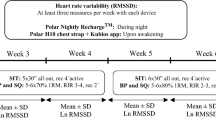Abstract
Waking ultradian rhythms in a visual performance task (detections and false positives) and in motility (global body movements and segmental limb movements during the task, and segmental limb movements during offtask periods) were examined in groups of nonmedicated hyperkinetic (HK) children (N=11) and matched normal controls (N=77). Testing was conducted for 5 minutes every 15 minutes (with 10minute “rest periods”) over a 6hour period on 2 consecutive days. Results revealed that HK subjects made significantly fewer detections (p<.05) and were more active (p<.01) during offtask periods on both days. Increased limb movement in HK subjects during the task was marginally significant (p<.06) on one day. False positives and global body movements failed to differentiate the groups. With regard to ultradian rhythmicity, some subjects in both groups showed evident ultradian peaks, which were present across a wide range of frequencies in one or more variables. There were no significant differences in the incidence of the period of evident ultradian peaks between the two groups.
Similar content being viewed by others
References
Anderson, R. P., Halcomb, C. G., & Doyle, R. B. The measurement of attention deficits.Exceptional Children, 1973,39, 534–539.
Aserinsky, E., & Kleitman, N. Regularly occurring periods of eye motility and concomitant phenomena during sleep.Science, 1953,118, 273–274.
Aserinsky, E., & Kleitman, N. Two types of ocular motility occurring in sleep.Journal of Applied Physiology, 1955,8, 1–10.
Barkley, R. A. The effects of methylphenidate on various types of activity level and attention in hyperkinetic children.Journal of Abnormal Child Psychology, 1977,5, 351–369.
Broughton, R. J. Biorhythmic variations in consciousness and psychological functions.Canadian Psychological Review, 1975,16, 217–239.
Conners, C. K. A teacher rating scale for use in drug studies with children.American Journal of Psychiatry, 1969,26, 884–888.
Conners, C. K. Symptom patterns in hyperkinetic, neurotic, and normal children.Child Development, 1970,41, 667–682.
Dement, W. C., & Kleitman, N. Cyclic variations in EEG during sleep and their relation to eye movements, body motility, and dreaming.Electroencephalography and Clinical Neurophysiology, 1957,9, 673–690.
Dixon, W. J. (Ed.)Biomedical computer programs. Los Angeles: University of California Press, 1973.
Ellis, M. J., Witt, P. A., Reynolds, R., & Sprague, R. L. Methylphenidate and the activity of hyperactives in the informal setting.Child Development, 1974,45, 217–220.
Globus, G. G., Drury, R. L., Phoebus, E. C., & Boyd, R. Ultradian rhythms in human performance.Perceptual and Motor Skills, 1971,33, 1171–1174.
Globus, G. G., Phoebus, E. C., Humphries, J., Boyd, R., & Sharp, R. Ultradian rhythms in human telemetered gross motor activity.Aerospace Medicine, 1973,44, 882–887.
Halberg, F. Organisms as circadian systems; temporal analysis of their physiologic and pathologic responses, including injury and death. InSymposium on medical aspects of stress. Washington, D.C.: Walter Reed Army Institute of Research, 1964.
Halberg, F. Chronobiology.Anual Review of Physiology, 1969,31, 675–725.
Juliano, D. B. Conceptual tempo, activity, and concept learning in hyperactive and normal children.Journal of Abnormal Psychology, 1974,83, 629–634.
Klein, R., & Armitage, R. Rhythms in human performance: 1 1/2-hour oscillations in cognitive style.Science, 1979,204, 1326–1328.
Kleitman, N.Sleep and wakefulness. Chicago: University of Chicago Press, 1963.
Kripke, D. F. Ultradian rhythms in sleep and wakefulness. In E. D. Weitzman (Ed.),Advances in sleep research (Vol. 1). New York: Spectrum, 1974.
Kripke, D. F., Wyborney, V. G., Mullaney, D. J., Messin, S., & Atkinson, M. No “basic restactivity cycle” in the wrist.Sleep Research, 1977,6, 218.
Lavie, P., Levy, C. M., & Coolidge, F. Ultradian rhythms in the perception of the spiral aftereffect: A sensitive detector of a basic biological rhythm.Behavioral Biology, 1974,11, 373–379.
Meier-Koll, A., Fels, T., Kofler, B., Schulz-Weber, U., & Thiessen, M. Basic rest activity cycle and stereotyped behavior of a mentally defective child.Neuropaediatrie, 1977,8, 172–180.
Orr, W. C., Hoffman, H. J., & Hegge, F. W. The assessment of time dependent changes in human performance.Chronobiologia, 1976,3, 293–305.
Rapoport, J. L., Quinn, P. O., Bradbard, G., Riddle, D., & Brooks, E. Imipramine and methylphenidate treatments of hyperactive boys.Archives of General Psychiatry, 1974,30, 789–793.
Rosenthal & Allen, T. W. An examination of attention, arousal, and learning dysfunctions of hyperkinetic children.Psychological Bulletin, 1978,85, 689–715.
Rosvold, H. E., Mirsky, A. F., Sarason, I., Bransome, E. D., & Beck, L. H. A continuous performance test of brain damage.Journal of Consulting Psychiatry, 1956,20, 343–350.
Sleator, E. K., & von Neumann, A. W. Methylphenidate in the treatment of hyperkinetic children.Clinical Pediatrics, 1974,13, 19–24.
Sykes, D. H., Douglas, V. I., & Morgenstern, G. Sustained attention in hyperactive children.Journal of Child Psychology and Psychiatry, 1973,14, 213–220.
Sykes, D. H., Douglas, V. I., Weiss, G., & Minde, K. K. Attention in hyperactive children and the effect of methylphenidate (Ritalin).Journal of Child Psychology and Psychiatry, 1971,12, 129–139.
Whalen, C. K., & Henker, B. Psychostimulants and children: A review and analysis.Psychological Bulletin, 1976,83, 1113–1130.
Author information
Authors and Affiliations
Additional information
We are grateful for the cooperation of the staff of the psychology department, Children's Hospital of Eastern Ontario, who referred the hyperkinetic children to the study, and we wish to thank Leah Schnitzer and Claude Manseau for their help in data acquisition and analysis. The study was supported by a grant from the Physicians' Services Incorporated Foundation.
Rights and permissions
About this article
Cite this article
Busby, K.A., Broughton, R.J. Waking ultradian rhythms of performance and motility in hyperkinetic and normal children. J Abnorm Child Psychol 11, 431–442 (1983). https://doi.org/10.1007/BF00914250
Revised:
Issue Date:
DOI: https://doi.org/10.1007/BF00914250




